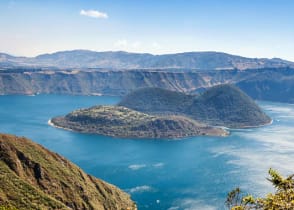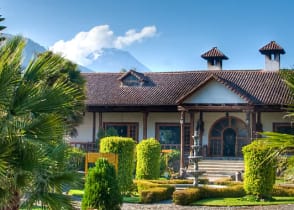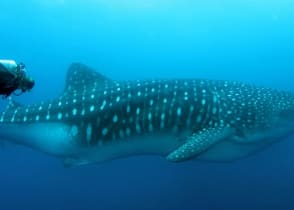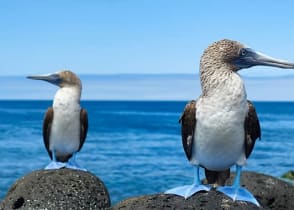What Are the Galapagos Islands Known For? Best Islands, Beaches, and Animals
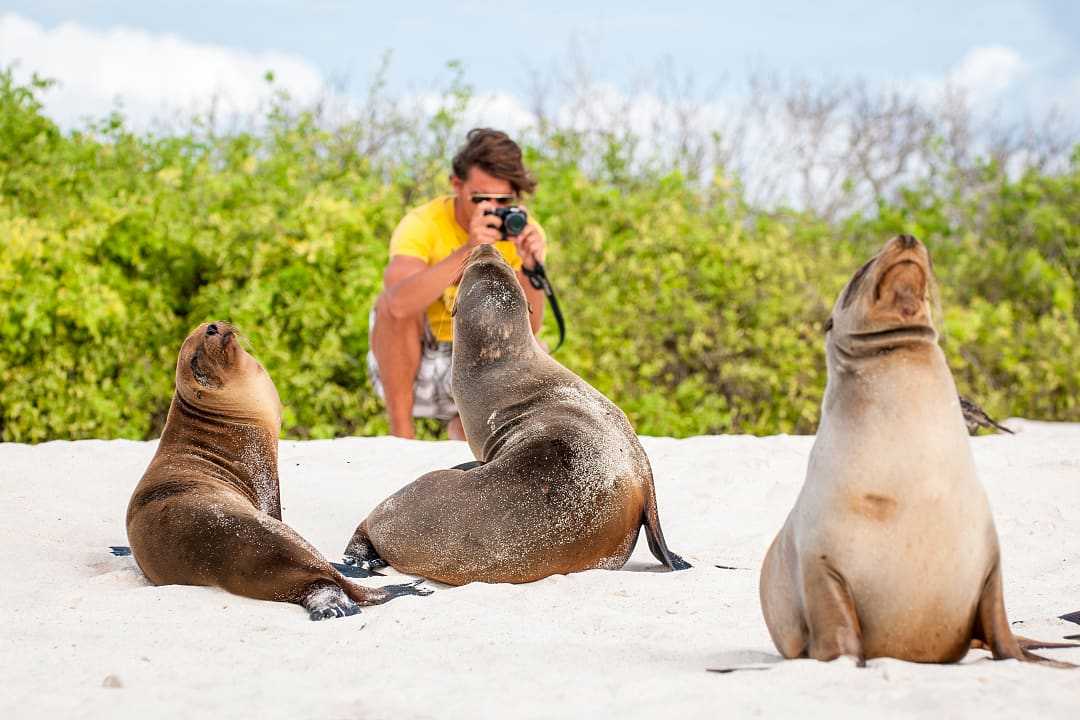
Galapagos Island, Ecuador
The best of the Galápagos features islands, beaches, and wildlife, creating an immersive environment in which you can explore and discover no matter the time of year.
The Galápagos Islands are famous for their remote location and unique animals along the land and sea. The volcanic topography has shaped fascinating landscapes across the archipelago, resulting in islands with tropical and desert foliage, as well as unforgettable beaches.
The following information shares our ideas on the best of the Galápagos, where you can bask in your preferred travel style as you search for wildlife, lounge on the coastline, or explore islands unlike anywhere else in the world.
Top Beaches in the Galapagos and Where to Find Them

Puerto Chino Beach, San Cristobal in the Galapagos
Playa Brava, Santa Cruz Island • Best Beach for Soft White Sands
When considering the shorelines of the various Galápagos, not many have the pristine sands you may expect from a collection of remote equatorial islands, but Playa Brava on the island of Santa Cruz often matches and surpasses traveler expectations.
Tortuga Bay offers a long stretch of powdery white sands lined by an edge of clear turquoise water that’s perfect for swimming, kayaking, or snorkeling. Absent of commercial life, including cafés and restaurants, the beach can feel ideal for relaxing in the warm sunlight or witnessing the wildlife, from sea turtles and blue-footed boobies to colorful fish and marine iguanas.
Playa Mansa, Santa Cruz Island • Best Beach for Swimming
Playa Mansa is located near Playa Brava in Tortuga Bay on Santa Cruz Island, but offers a very different ambiance. Taking the trail through the mangrove forest can make Mansa Beach feel like a remote corner of the world and an undiscovered treasure.
The waters in the natural bay are calm and welcoming, with the shape of the coastline protecting the shores from waves. Instead, Playa Mansa is a perfect place to swim and bask in the comfortable temperatures, crystal-clear visibility, and possible sightings of reef sharks, rays, and sea turtles moving through the water.
Puerto Chino Beach, San Cristobal • Best Beach for Scenery
Puerto Chino on San Cristobal Island is another rare gem among the beaches of the Galápagos, with surprising white sands and views of the turquoise sea.
Finches often populate the nearby mangroves opposite the shoreline and sea lions lounge on the rocky outcrop leading to the water. The combination of wildlife, forest, white sands, and colorful waters make Puerto Chino Beach an exceptional place to soak up the sun and scenery.
The waves offer a nice place to surf and the nearby trails open to panoramas sweeping across a landscape populated with lava lizards and yellow warblers, prickly pear cactus and blue-footed boobies.
Learn more: Top Things to Do in Ecuador and the Galápagos Islands
Top Islands in the Galapagos

Sierra Negra Volcano on Isabela Island in the Galapagos
Isabela Island • Best Island for Flora and Fauna
While bigger doesn’t always mean better, Isabela Island is the largest of the Galápagos archipelago and possesses six volcanoes, including Volcan Wolf, the highest point of the Galápagos Islands. All of the volcanoes are active, continuously adding to the landmass, while simultaneously altering the vegetation.
Penguins, flamingos, and flightless cormorants demonstrate the untouched wildlife grazing around the unique topography, while the famous Galápagos tortoises lumber near the cacti, taking water from early-morning dew. Find new lava fields, impressive examples of volcanic craters, and meandering trails winding around the island’s more than 1,800 square miles.
San Cristobal • Best Island for Diving and Snorkeling
Isabela Island may be the largest island in the Galápagos, but San Cristobal is the main island in the region.
With the largest year-round population and the most infrastructure of all the islands, San Cristobal can feel like the home of a large city when compared to the uninhabited wilderness of the surrounding archipelago. Most travelers arrive and depart the islands from San Cristobal. The marine life offers an extra layer of fascination for visitors interested in snorkeling or diving to view the fascinating world beneath the waves.
Sites like Isla Lobos, where blue-footed boobies and sea lions thrive, attract many curious sightseers, but Kicker Rock hosts incredible crystal-clear waters, with clarity reaching exceptional depths in which to find eagle rays, turtles, and hammerhead sharks.
Santa Cruz • Best Island for Wildlife and Birding
Wildlife is often visible around the Galápagos archipelago, but on Santa Cruz Island, it takes center stage, with sightings commonplace among the distinctive shifting landscapes. Witness marine iguanas lounging in the sun, find Sally Lightfoot crabs marching across the sand, witness sea turtles laying eggs, or watch flamboyant flamingos graze in the lagoon.
Whether scouring the coastline for stunning views of life and sea or trekking to the highlights for a panorama and signs of the vermilion flycatcher, Santa Cruz is an enchanting place for marine life and birds.
Learn more: Best Places to Visit in Ecuador and the Galápagos Islands
Top Animals to See in the Galapagos and Where to Find Them

Blue-footed boobies in the Galapagos Islands
Giant Tortoise
The Galápagos giant tortoise is one of the region’s most iconic animals. They can grow to over 880 pounds and live more than 100 years. When in the wild, they can survive for a year without food or water, and prefer to feed on grass, fruit, and cactus pads.
Found mainly in the Santa Cruz highlands and the Alcedo Volcano region on Isabela island, you can often find them with a Galápagos finch on their back feeding on ticks hiding in the tortoise’s skin.
Galápagos Penguin
Galápagos penguins are known as much for their small stature as for their surprising settlement choice on the arid and warm Galápagos archipelago. As one of the smallest penguins in the world, they grow to just over one and a half feet tall on average and weigh less than six pounds.
They are found mainly on Isabela and Fernandina islands, but have smaller colonies on Floreana, Santiago, and Bartolomé. The Galápagos penguins have few land predators, but are often hunted vigorously in the water by seals, sea lions, and sharks. Fishing nets have also become a problem, with a number of penguins caught as by-catch each year.
While closely related to other penguin species, Galápagos penguins have adapted to the conditions of the islands by using caves and crevices for nesting grounds instead of searching for moss or grasses in which to burrow.
Blue-footed Booby
Blue-footed boobies are one of the most famous birds of the Galápagos islands. They are known for their clumsy movements on land and the renowned bright-blue tint of their webbed feet.
They grow up to 33 inches tall, with a wingspan reaching nearly five feet wide. They are incredibly agile when flying and can quickly plunge into the water at speeds of up to 60 miles an hour when finding schools of sardines or anchovies on which to feed.
They are common on Santa Cruz, Española, Fernandina, and Floreana islands, but North Seymour has become the most popular island on which to view blue-footed booby colonies because the open space makes it easier to witness the birds performing their courtship dance.
Galapagos Islands Luxury Cruises

A luxury yacht in the Galapagos. Photo courtesy of: MY Kontiki Wayra
From Galápagos Islands private yacht and catamaran cruises to sailing the region on intimate expedition ships, you will have an unforgettable time exploring this unique ecosystem in style.
The vessels provide exceptional comfort and service while navigating the breathtaking landscapes and diverse wildlife of the archipelago. Each luxury Galápagos cruise promises lavish accommodations and curated excursions, allowing you to engage deeply with the wonders of this UNESCO World Heritage site.
Luxury Private Yachts
Cruising on a private yacht when looking for luxury Galápagos cruises for an unparalleled level of glamour and personalization as you explore this extraordinary archipelago. With a dedicated crew, chef, and naturalist guides, tailored itineraries will cater to your interests and preferences. Activities like snorkeling with sea lions, hiking through lush landscapes, or simply relaxing on deck while taking in breathtaking views are what you can expect on tours that allow you to adjust your daily outings based on wildlife sights and your interests. In the evenings, sit down to gourmet meals prepared to suit your tastes.
Luxury Catamarans
Ultra-luxury Galápagos catamarans generally accommodate 24 guests in 12 opulent suites. Some feature private balconies and jacuzzis to ensure you enjoy breathtaking ocean views in the utmost comfort. Relax in lounges and dine alfresco on gourmet meals. By day, take guided excursions to explore the wildlife and landscapes of the islands or snorkel and kayak. Experience dedicated personalized service on your Galápagos luxury catamaran cruise that will ensure minimal environmental impact through sustainable practices.
Luxury Expedition Ships
Galápagos Islands luxury cruises have expedition ships that accommodate approximately 100 passengers for an intimate yet spacious cruising experience. These vessels feature advanced technology that allows navigation of delicate ecosystems without causing damage. The suites have luxurious amenities, including wraparound balconies and marble bathrooms, with around-the-clock butler service.
You can expect multiple dining options, fitness centers, and observation lounges perfect for stargazing. Expert naturalist guides lead excursions to explore the islands' flora and fauna and you can enjoy activities like snorkeling, hiking, and wildlife watching while learning about the archipelago's ecological significance.
Luxury Yachts
A luxury Galapagos cruise on a state-of-the-art mega catamaran accommodates fewer than 20 passengers, providing a highly personalized cruising experience. With spacious cabins that include private balconies and modern amenities, onboard facilities include semi-covered sky decks for al fresco dining, salons with panoramic views, and Jacuzzis with sun terraces for relaxation after excursions.
Explore iconic sites like Rabida Island and Bartolomé Island while engaging in paddle boarding and snorkeling. The attentive crews ensure your needs are met while emphasizing eco-friendly practices to preserve the pristine environment. With its intimate setting and focus on exploration, these luxury yachts offer a spectacular gateway to one of nature's most extraordinary destinations.
Experience the Best of What the Galapagos Islands Are Known For

Giant tortoises on Santa Cruz island in the Galapagos
From the shores of Santa Cruz to the wildlife of Isabela Island, the Galápagos are a destination unlike anywhere else in the world. Plunge into the crystal-clear waters to find coral gardens and vibrant marine life, or wander through surprisingly lush foliage that opens to images of ancient tortoises and panoramic sea views.
As you look for inspiration for your trip, you can discover more ideas on how to experience the adventure with our Galápagos Islands vacations or enjoy discovering when to visit and more with tips from our Galápagos Islands and Ecuador travel guide.
Life-Enriching Travel Designed Just for You
- 1
Trips curated by the world’s top destination experts
- 2
Concierge-level service leading up to and during your trip
- 3
Unique, exclusive experiences and insider access
